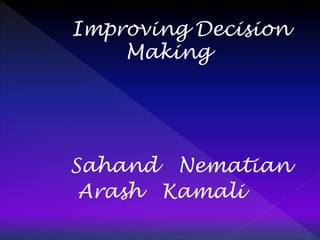Report
Share

More Related Content
Viewers also liked
Viewers also liked (11)
Assignment9 88207102- -dehdarian-cohen-absorptive capacity

Assignment9 88207102- -dehdarian-cohen-absorptive capacity
More from Omid Aminzadeh Gohari
More from Omid Aminzadeh Gohari (20)
Improving dm
- 1. Improving Decision Making Sahand Nematian Arash Kamali
- 9. Group 1: AWARENESS OF OUR COGNITIVE LIMITATIONS AND SUSCEPTIBILITY TO BIAS Group 2: POVIDE IMPROVING SPECIFIC DECISION IN SPECIFIC SITUATION
- 10. ACQUIRING EXPERIENCE AND EXPERTISE REDUCING BIASE IN YOUR JUDGEMENT ANALOGCAL REASONING TAKING AN OUTSIDER’S VIEW USING LINEAR MODELS UNDERSTANDING BIAS IN OTHERS
- 16. Factors that inhibit individuals from changing 1. Satisfaction with current status 2. Risk aversion 3. Preference for certain outcomes to uncertain innovative outcomes
